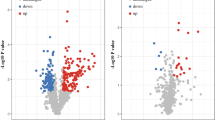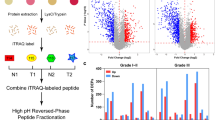Abstract
This study presents a proteomic method that differentiates between matched normal and breast tumor tissues from ductal carcinoma in situ (DCIS) and invasive carcinoma from Korean women, to identify biomarker candidates and to understand pathogenesis of breast cancer in protein level. Proteins from tissues obtained by biopsy were extracted by RIPA buffer, digested by the gel-assisted method, and analyzed by nano-UPLC-MS/MS. From proteomic analysis based on label-free quantitation strategy, a non-redundant list of 298 proteins was identified from the normal and tumor tissues, and 244 proteins were quantified using IDEAL-Q software. Hierarchical clustering analysis showed two patterns classified as two groups, invasive carcinoma and DCIS, suggesting a difference between two carcinoma at the protein expression level as expected. Differentially expressed proteins in tumor tissues compared to the corresponding normal tissues were related to three biological pathways: antigen-processing and presentation, glycolysis/gluconeogenesis, and complement and coagulation cascades. Among them, the up-regulation of calreticulin (CRT) and protein disulfide isomerase A3 (PDIA3) was confirmed by Western blot analysis. In conclusion, this study showed the possibility of identifying biomarker candidates for breast cancer using tissues and might help to understand the pathophysiology of this cancer at the protein level.
Similar content being viewed by others
References
Alaiya, A., Roblick, U., Egevad, L., Carlsson, A., Franzen, B., Volz, D., Huwendiek, S., Linder, S., and Auer, G., Polypeptide expression in prostate hyperplasia and prostate adenocarcinoma. Anal. Cell. Pathol., 21, 1–9 (2000).
Beckmann, M. W., Niederacher, D., Schnurch, H. G., Gusterson, B. A., and Bender, H. G., Multistep carcinogenesis of breast cancer and tumour heterogeneity. J. Mol. Med., 75, 429–439 (1997).
Bianchi, L., Canton, C., Bini, L., Orlandi, R., Menard, S., Armini, A., Cattaneo, M., Pallini, V., Bernardi, L. R., and Biunno, I., Protein profile changes in the human breast cancer cell line MCF-7 in response to SEL1L gene induction. Proteomics, 5, 2433–2442 (2005).
Bini, L., Magi, B., Marzocchi, B., Arcuri, F., Tripodi, S., Cintorino, M., Sanchez, J. C., Frutiger, S., Hughes, G., Pallini, V., Hochstrasser, D. F., and Tosi, P., Protein expression profiles in human breast ductal carcinoma and histologically normal tissue. Electrophoresis, 18, 2832–2841 (1997).
Bouchal, P., Roumeliotis, T., Hrstka, R., Nenutil, R., Vojtesek, B., and Garbis, S. D., Biomarker discovery in low-grade breast cancer using isobaric stable isotope tags and two-dimensional liquid chromatography-tandem mass spectrometry (iTRAQ-2DLC-MS/MS) based quantitative proteomic analysis. J. Proteome. Res., 8, 362–373 (2009).
Brinck, U., Eigenbrodt, E., Oehmke, M., Mazurek, S., and Fischer, G., L- and M2-pyruvate kinase expression in renal cell carcinomas and their metastases. Virchows Arch., 424, 177–185 (1994).
Burke, R. E., Harris, S. C., and Mcguire, W. L., Lactate dehydrogenase in estrogen-responsive human breast cancer cells. Cancer Res., 38, 2773–2776 (1978).
Cho, Y. E., Singh, T. S., Lee, H. C., Moon, P. G., Lee, J. E., Lee, M. H., Choi, E. C., Chen, Y. J., Kim, S. H., and Baek, M. C., In-depth identification of pathways related to cisplatininduced hepatotoxicity through an integrative method based on an informatics-assisted label-free protein quantitation and microarray gene expression approach. Mol. Cell. Proteomics., 11, M111.010884 (2012).
Conway, E. M., Liu, L., Nowakowski, B., Steiner-Mosonyi, M., Ribeiro, S. P., and Michalak, M., Heat shock-sensitive expression of calreticulin. In vitro and in vivo up-regulation. J. Biol. Chem., 270, 17011–17016 (1995).
Corcoran, E., Phelan, J. J., and Fottrell, P. F., Purification and properties of pyruvate kinase from human lung. Biochim. Biophys. Acta, 446, 96–104 (1976).
Franzen, B., Linder, S., Alaiya, A. A., Eriksson, E., Uruy, K., Hirano, T., Okuzawa, K., and Auer, G., Analysis of polypeptide expression in benign and malignant human breast lesions: down-regulation of cytokeratins. Br. J. Cancer, 74, 1632–1638 (1996).
Garbi, N., Tanaka, S., Momburg, F., and Hammerling, G. J., Impaired assembly of the major histocompatibility complex class I peptide-loading complex in mice deficient in the oxidoreductase ERp57. Nat. Immunol., 7, 93–102 (2006).
Han, C. L., Chien, C. W., Chen, W. C., Chen, Y. R., Wu, C. P., Li, H., and Chen, Y. J., A multiplexed quantitative strategy for membrane proteomics: opportunities for mining therapeutic targets for autosomal dominant polycystic kidney disease. Mol. Cell. Proteomics., 7, 1983–1997 (2008).
Heal, R. and McGivan, J., Induction of calreticulin expression in response to amino acid deprivation in Chinese hamster ovary cells. Biochem. J., 329(Pt 2), 389–394 (1998).
Hendershot, L. M., Valentine, V. A., Lee, A. S., Morris, S. W., and Shapiro, D. N., Localization of the gene encoding human BiP/GRP78, the endoplasmic reticulum cognate of the HSP70 family, to chromosome 9q34. Genomics, 20, 281–284 (1994).
Janeway, C., Immunobiology: the immune system in health and disease, Garland Science, New York, (2005).
Kenny, P. A., Lee, G. Y., Myers, C. A., Neve, R. M., Semeiks, J. R., Spellman, P. T., Lorenz, K., Lee, E. H., Barcellos-Hoff, M. H., Petersen, O. W., Gray, J. W., and Bissell, M. J., The morphologies of breast cancer cell lines in threedimensional assays correlate with their profiles of gene expression. Mol. Oncol., 1, 84–96 (2007).
Macdonald, M. J. and Chang, C. M., Pancreatic islets contain the M2 isoenzyme of pyruvate kinase. Its phosphorylation has no effect on enzyme activity. Mol. Cell. Biochem., 68, 115–120 (1985).
Michalak, M., Corbett, E. F., Mesaeli, N., Nakamura, K., and Opas, M., Calreticulin: one protein, one gene, many functions. Biochem. J., 344Pt 2, 281–292 (1999).
Moon, P. G., Lee, J. E., You, S., Kim, T. K., Cho, J. H., Kim, I. S., Kwon, T. H., Kim, C. D., Park, S. H., Hwang, D., Kim, Y. L., and Baek, M. C., Proteomic analysis of urinary exosomes from patients of early IgA nephropathy and thin basement membrane nephropathy. Proteomics, 11, 2459–2475 (2011).
Ostwald, T. J. and Maclennan, D. H., Isolation of a high affinity calcium-binding protein from sarcoplasmic reticulum. J. Biol. Chem., 249, 974–979 (1974).
Parkin, D. M., Bray, F., Ferlay, J., and Pisani, P., Global cancer statistics, 2002. CA Cancer J. Clin., 55, 74–108 (2005).
Polyak, K., On the birth of breast cancer. Biochim. Biophys. Acta, 1552, 1–13 (2001).
Ramsamooj, P., Notario, V., and Dritschilo, A., Enhanced expression of calreticulin in the nucleus of radioresistant squamous carcinoma cells in response to ionizing radiation. Cancer Res., 55, 3016–3021 (1995).
Reinacher, M. and Eigenbrodt, E., Immunohistological demonstration of the same type of pyruvate kinase isoenzyme (M2-Pk) in tumors of chicken and rat. Virchows Arch. B Cell Pathol. Incl. Mol. Pathol., 37, 79–88 (1981).
Russo, J. and Russo, I. H., Cellular basis of breast cancer susceptibility. Oncol. Res., 11, 169–178 (1999).
Schering, B., Eigenbrodt, E., Linder, D., and Schoner, W., Purification and properties of pyruvate kinase type M2 from rat lung. Biochim. Biophys. Acta, 717, 337–347 (1982).
Son, B. H., Kwak, B. S., Kim, J. K., Kim, H. J., Hong, S. J., Lee, J. S., Hwang, U. K., Yoon, H. S., and Ahn, S. H., Changing patterns in the clinical characteristics of Korean patients with breast cancer during the last 15 years. Arch. Surg., 141, 155–160 (2006).
Sutton, C. W., Pemberton, K. S., Cottrell, J. S., Corbett, J. M., Wheeler, C. H., Dunn, M. J., and Pappin, D. J., Identification of myocardial proteins from two-dimensional gels by peptide mass fingerprinting. Electrophoresis, 16, 308–316 (1995).
Ting, J. and Lee, A. S., Human gene encoding the 78,000-dalton glucose-regulated protein and its pseudogene: structure, conservation, and regulation. DNA, 7, 275–286 (1988).
Tolle, S. W., Dyson, R. D., Newburgh, R. W., and Cardenas, J. M., Pyruvate kinase isozymes in neurons, glia, neuroblastoma, and glioblastoma. J. Neurochem., 27, 1355–1360 (1976).
Truong, K., Guilly, M. N., Gerbault-Seureau, M., Malfoy, B., Vielh, P., and Dutrillaux, B., Evidence for in vitro selection during cell culturing of breast cancer: detection by flow and image cytometry. Cancer Genet. Cytogenet., 114, 154–155 (1999).
Tsou, C. C., Tsai, C. F., Tsui, Y. H., Sudhir, P. R., Wang, Y. T., Chen, Y. J., Chen, J. Y., Sung, T. Y., and Hsu, W. L., IDEAL-Q, an automated tool for label-free quantitation analysis using an efficient peptide alignment approach and spectral data validation. Mol. Cell. Proteomics., 9, 131–144 (2010).
Yoo, K. Y., Kang, D., Park, S. K., Kim, S. U., Shin, A., Yoon, H., Ahn, S. H., Noh, D. Y., and Choe, K. J., Epidemiology of breast cancer in Korea: occurrence, high-risk groups, and prevention. J. Korean Med. Sci., 17, 1–6 (2002).
Yoon, G. S., Lee, H., Jung, Y., Yu, E., Moon, H. B., Song, K., and Lee, I., Nuclear matrix of calreticulin in hepatocellular carcinoma. Cancer Res., 60, 1117–1120 (2000).
Yu, L. R., Zeng, R., Shao, X. X., Wang, N., Xu, Y. H., and Xia, Q. C., Identification of differentially expressed proteins between human hepatoma and normal liver cell lines by two-dimensional electrophoresis and liquid chromatographyion trap mass spectrometry. Electrophoresis, 21, 3058–3068 (2000).
Author information
Authors and Affiliations
Corresponding author
Rights and permissions
About this article
Cite this article
Song, MN., Moon, PG., Lee, JE. et al. Proteomic analysis of breast cancer tissues to identify biomarker candidates by gel-assisted digestion and label-free quantification methods using LC-MS/MS. Arch. Pharm. Res. 35, 1839–1847 (2012). https://doi.org/10.1007/s12272-012-1018-6
Received:
Revised:
Accepted:
Published:
Issue Date:
DOI: https://doi.org/10.1007/s12272-012-1018-6




